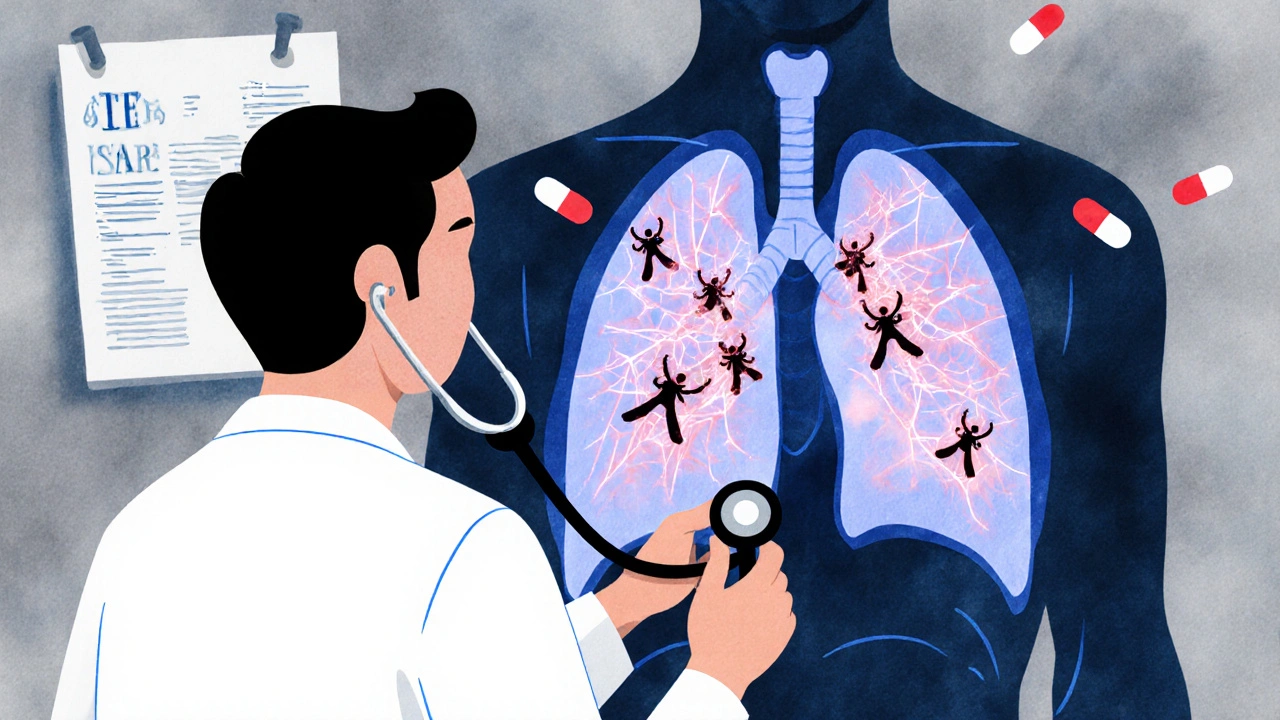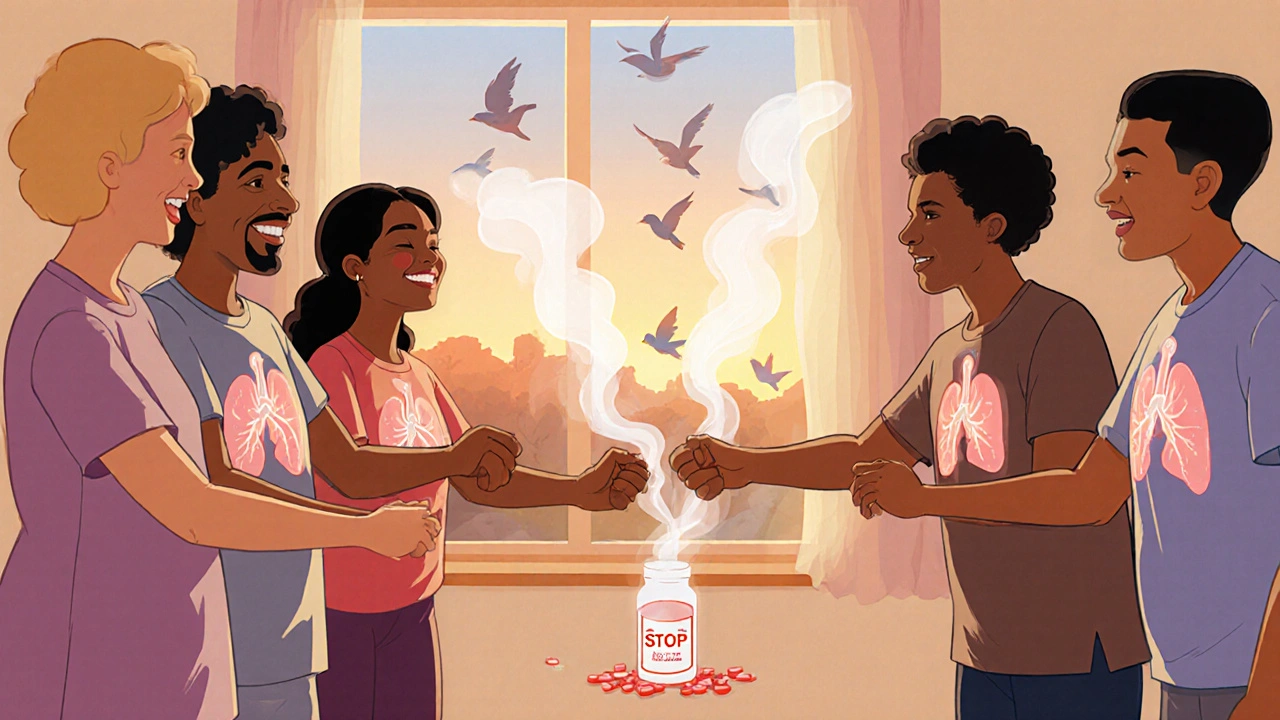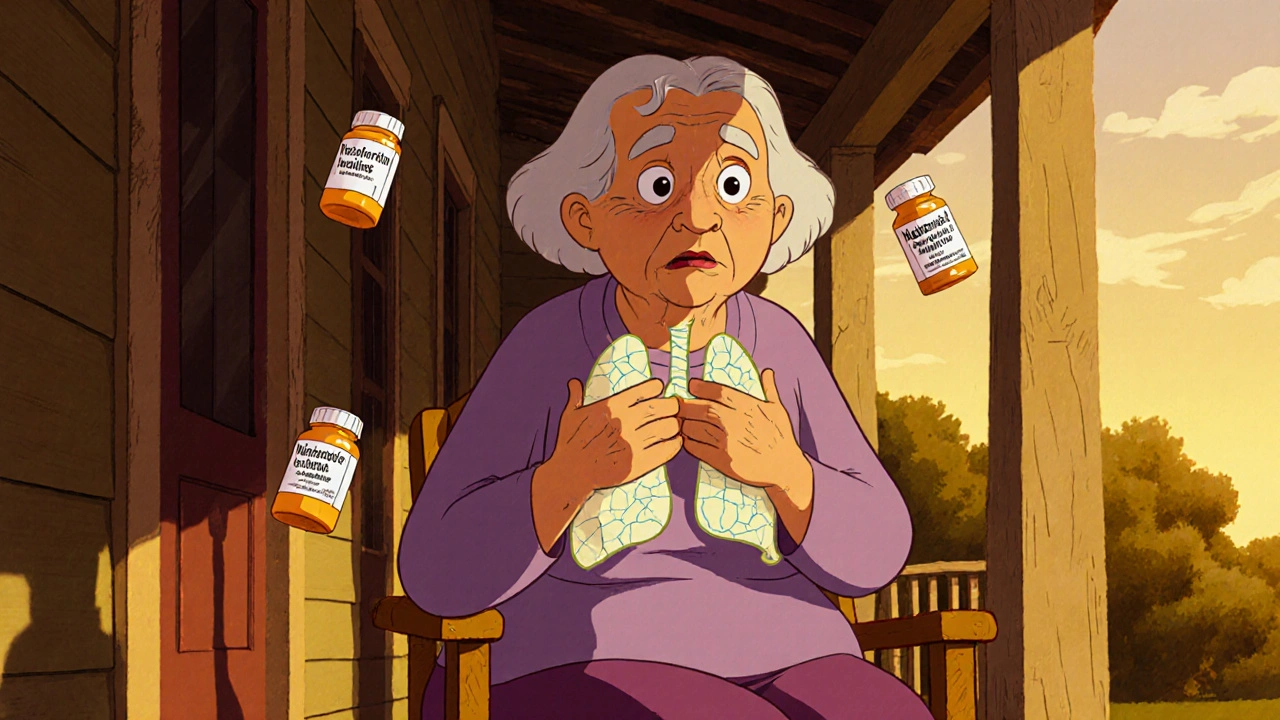Drug-Induced Pulmonary Fibrosis Risk Assessment
Medication Risk Assessment
This tool helps you assess your risk of developing drug-induced pulmonary fibrosis based on your medications and health factors. Results are for informational purposes only and should not replace medical advice.
Most people assume that if a doctor prescribes a medication, it’s safe. But some drugs don’t just treat illness-they can quietly scar your lungs. Drug-induced pulmonary fibrosis is one of the most dangerous, yet underrecognized, side effects of common prescriptions. It doesn’t come with warning signs you can easily spot. No rash. No nausea. Just a dry cough that won’t go away, and breathlessness that gets worse every week. By the time it’s diagnosed, the damage is often permanent.
What Exactly Is Drug-Induced Pulmonary Fibrosis?
Pulmonary fibrosis means scar tissue builds up in your lungs. Normally, the tiny air sacs (alveoli) stretch and relax to move oxygen into your blood. When scar tissue replaces healthy tissue, those sacs stiffen. Breathing becomes like trying to suck air through a clogged straw. Drug-induced pulmonary fibrosis happens when certain medications trigger this scarring process. It’s not an allergic reaction. It’s not an overdose. It’s unpredictable-some people get it after a few months, others after years, and most never do at all.
The exact reason why only some people develop it remains unknown. Researchers think it has to do with how your body metabolizes the drug, your genetics, and your age. Older adults are at higher risk. So are people with pre-existing lung conditions. But even healthy 60-year-olds on routine medications can develop it. The key is that this isn’t rare. Between 2014 and late 2024, New Zealand’s pharmacovigilance system recorded 173 cases linked to medications-with 30 deaths. That’s a 17% fatality rate. And those are just the reported cases. Many more go undiagnosed.
The Top Medications That Cause Lung Scarring
Over 50 drugs have been linked to pulmonary fibrosis. But a handful account for the vast majority of cases. Here are the most dangerous ones, backed by real-world data:
- Nitrofurantoin-Used for urinary tract infections, especially in older women on long-term prevention. Over 47 cases were reported in New Zealand between 2014 and 2024. Symptoms can appear after 6 months or even 10 years. It’s often mistaken for pneumonia or aging.
- Methotrexate-A common treatment for rheumatoid arthritis and psoriasis. About 3-7% of users develop lung inflammation that turns into fibrosis. In New Zealand, 45 cases were reported in 10 years. It can strike suddenly-sometimes within weeks-with fever, cough, and rapid breathing.
- Amiodarone-Prescribed for irregular heart rhythms. About 5-7% of long-term users develop lung damage. Risk rises after taking more than 400 grams total. It’s slow to show up-usually after 6 to 12 months. But once it does, it’s hard to reverse.
- Bleomycin-A chemotherapy drug. Up to 20% of patients on high doses develop severe lung scarring. It’s one of the most toxic in this category. Doctors know the risk, but it’s still used because it’s effective against certain cancers.
- Cyclophosphamide-Another chemo drug. Around 3-5% of users get lung injury. It’s often combined with other drugs, making it harder to pinpoint.
- Immune checkpoint inhibitors-Newer cancer drugs like pembrolizumab and nivolumab. Since their approval in 2011, reports of lung fibrosis have jumped. The immune system, unleashed to fight cancer, sometimes attacks the lungs instead.
What’s scary is that these drugs aren’t obscure. Nitrofurantoin is one of the most prescribed antibiotics for UTIs. Methotrexate is a go-to for arthritis. Amiodarone is used in millions of heart patients. If you’re on any of these, you’re not a statistical outlier-you’re a regular patient.
How Do You Know If It’s Your Medication?
The symptoms are easy to ignore. A dry cough. Feeling winded climbing stairs. Tired all the time. Many patients assume it’s just getting older. Or they blame their asthma, their weight, or a cold that won’t quit. But if you’ve been on one of these drugs for more than a few months and you’re noticing these changes, don’t brush it off.
According to patient reports from pulmonary fibrosis support groups, the average time from first symptom to correct diagnosis is 8.2 weeks. That’s two months of lung damage happening while doctors look elsewhere. The key clues:
- Cough that doesn’t respond to cough medicine
- Shortness of breath during normal activities (walking, showering, dressing)
- Crackling sound in lungs when a doctor listens with a stethoscope
- Low oxygen levels during a simple walk test
- Scarring visible on a high-resolution CT scan of the chest
There’s no single test that says, “This drug caused this.” Diagnosis is a process of elimination. Your doctor must rule out infections, autoimmune diseases, asbestos exposure, and other lung conditions. That’s why your medication history matters more than you think. Bring a full list-prescriptions, supplements, even over-the-counter drugs. Don’t assume your doctor knows what you’re taking. Many don’t ask.

What Happens If You Keep Taking the Drug?
Continuing the medication means more scarring. And scarring is permanent. Once collagen builds up in the lungs, it doesn’t go away. Stopping the drug early is the only way to stop progression. In fact, 89% of patients who stop the offending drug within 3 months see improvement. Their lungs heal, their breathing gets better, their oxygen levels rise.
But if you wait too long? The damage becomes irreversible. About 15-25% of patients end up with permanent lung function loss-even after stopping the drug. And in severe cases, mortality hits 10-20%. Amiodarone-induced fibrosis, for example, kills 1 in 5 patients even after treatment stops.
That’s why timing is everything. The earlier you catch it, the better your chances. Waiting for a CT scan or a referral to a lung specialist isn’t just inconvenient-it’s dangerous.
How Is It Treated?
There’s no cure for the scarring itself. But you can stop it from getting worse-and sometimes reverse some of the damage.
The first step is always stopping the drug. That’s non-negotiable. The second step? High-dose steroids. Prednisone, usually 0.5 to 1 mg per kilogram of body weight daily, for 3-6 months. It reduces inflammation and slows further scarring. Many patients feel better within weeks.
Oxygen therapy is used if your blood oxygen drops below 88%. It doesn’t fix the lungs, but it keeps you alive and active while your body heals. Pulmonary rehab-breathing exercises, light exercise training, education-helps most patients regain strength and confidence.
But here’s the hard truth: if the fibrosis is advanced, steroids won’t help much. That’s why prevention and early detection are the only real wins.

Who’s at Risk-and What Should You Do?
You’re at higher risk if you:
- Are over 60
- Take nitrofurantoin, methotrexate, or amiodarone long-term
- Have a history of lung disease or smoking
- Are on multiple medications (drug interactions increase risk)
Here’s what to do now:
- If you’re on any of the high-risk drugs listed above, ask your doctor: “Could this be affecting my lungs?”
- Get a baseline pulmonary function test (PFT) before starting long-term therapy.
- Keep a symptom journal: note when you feel winded, when you cough, if you feel feverish.
- If you develop a new cough or breathlessness, don’t wait. Go to your doctor and say: “I’m on [drug name]. Could this be lung damage?”
- Ask for a chest CT scan if symptoms persist. It’s the only way to see early scarring.
Primary care doctors miss this diagnosis more than you think. A 2022 survey found only 58% routinely screen for lung symptoms in patients on high-risk drugs. That means nearly half of patients are flying blind. Don’t be one of them.
The Bigger Picture
Drug-induced pulmonary fibrosis is rising. Reported cases have gone up 23.7% over the past decade. Why? More people are on long-term medications. More new drugs are hitting the market-especially cancer immunotherapies-with unknown lung risks. And our systems aren’t keeping up.
Regulators in New Zealand, the U.S., and Europe are now pushing for better warnings. Some hospitals are starting to recommend baseline lung tests before prescribing amiodarone or methotrexate. But it’s still not standard. You have to ask.
This isn’t just about one drug. It’s about trusting your body. If something feels off, it probably is. If your breath isn’t what it used to be, don’t assume it’s age. Don’t assume it’s nothing. Your lungs can’t tell you they’re being damaged. You have to be their advocate.
Can you get pulmonary fibrosis from antibiotics?
Yes. Nitrofurantoin, a common antibiotic for urinary tract infections, is one of the top drugs linked to lung scarring. It’s often prescribed for long-term prevention, especially in older women. Symptoms can appear months or even years after starting the drug. Other antibiotics like sulfonamides (sulfa drugs) have also been linked, though less commonly.
Is drug-induced pulmonary fibrosis reversible?
It can be-if caught early. Stopping the offending drug within the first few months often allows the lungs to heal. Up to 89% of patients improve after discontinuation. But if scarring has advanced, the damage is permanent. Early detection is the only way to avoid lifelong breathing problems.
How long does it take for amiodarone to damage the lungs?
Amiodarone-induced lung damage usually develops after 6 to 12 months of use, but it can take longer. Risk increases significantly after taking more than 400 grams total. Symptoms like cough and shortness of breath often start slowly, so they’re easy to miss. Regular lung checks are recommended for anyone on amiodarone for over 6 months.
Can methotrexate cause sudden lung problems?
Yes. Methotrexate can cause acute pneumonitis-a sudden, severe lung inflammation-that can turn into fibrosis within weeks. It’s not always slow. Patients may develop fever, cough, and rapid breathing after just a few doses. This is a medical emergency. Stop the drug and seek help immediately.
Should I stop my medication if I have a cough?
Don’t stop on your own. But do contact your doctor right away. A new, persistent cough while on a high-risk drug like nitrofurantoin, methotrexate, or amiodarone could be a sign of lung damage. Your doctor may order a chest CT scan or lung function test. Never ignore new breathing symptoms-especially if you’re on one of these medications.
What Comes Next?
The future of preventing drug-induced pulmonary fibrosis lies in better screening and personalized medicine. Researchers are looking for genetic markers that predict who’s at risk before they even start a drug. Clinical trials are testing blood tests that detect early lung injury-before symptoms appear.
Until then, your best defense is awareness. Know the drugs that can harm your lungs. Track your symptoms. Speak up. Your lungs don’t scream-they whisper. And if you don’t listen, the damage will keep building, silently, until it’s too late.

Comments
AARON HERNANDEZ ZAVALA
Man I never knew some of these meds could do this to your lungs. I've been on nitrofurantoin for years for recurrent UTIs and I just thought my cough was from allergies. Guess I'm getting that CT scan next week.
On November 20, 2025 AT 12:39
Lyn James
It's not just about the drugs-it's about the entire medical-industrial complex that pushes pills like candy while ignoring the silent killers. Doctors are overworked, yes, but they're also complicit in this slow genocide of patients who are told to 'just breathe easier' while their lungs turn to concrete. We've normalized chemical harm because convenience is king. Wake up.
On November 22, 2025 AT 06:11
Craig Ballantyne
There's a well-documented pharmacokinetic vulnerability in elderly patients with reduced hepatic clearance-particularly with amiodarone, which has an extremely long half-life. The fibrotic cascade is mediated by TGF-beta upregulation and fibroblast activation. Baseline PFTs and HRCT surveillance should be protocol, not an afterthought.
On November 23, 2025 AT 06:47
Victor T. Johnson
They don't want you to know this. Pharma doesn't care. Your doctor's too busy with paperwork. But your lungs? They remember every pill. I lost my uncle to this. He was on methotrexate for psoriasis. They told him it was 'just a cold.' He was dead in 11 months. 😔
On November 24, 2025 AT 17:55
Nicholas Swiontek
Hey everyone-this is huge. If you're on any of these meds, please don't panic, but DO talk to your doctor. Get a baseline test. Keep a symptom log. I've been helping my mom through this after she was diagnosed with amiodarone fibrosis-early detection saved her. You're not alone. 💪❤️
On November 25, 2025 AT 18:57
Robert Asel
It is imperative to note that the incidence of drug-induced pulmonary fibrosis remains statistically insignificant when compared to the total volume of prescriptions dispensed. While anecdotal evidence is compelling, one must exercise caution against conflating correlation with causation. The medical literature does not support blanket alarmism.
On November 27, 2025 AT 00:44
Shannon Wright
This is one of those silent epidemics that flies under the radar because it doesn’t make headlines. But for the people living it? It’s everything. I’ve seen patients go from hiking every weekend to needing oxygen just to shower. If you’re over 60 and on long-term meds, please, please, please ask your doctor about lung screening. It’s not paranoia-it’s prevention. You deserve to breathe easy.
On November 28, 2025 AT 06:41
vanessa parapar
Oh please. If you’re old enough to be on amiodarone, you’re old enough to know your body’s changing. It’s not the drug’s fault-you’re just getting old. Stop blaming medicine and start taking responsibility. Also, stop Googling symptoms. You’re giving yourself anxiety.
On November 28, 2025 AT 07:30
Ben Wood
...and yet... the FDA... has... no... mandatory... pulmonary... monitoring... protocol... for... nitrofurantoin... despite... 173... documented... cases... and... 30... deaths... in... New... Zealand... alone... (source: Medsafe)... this... is... a... systemic... failure... of... regulatory... oversight... and... corporate... negligence... period.
On November 30, 2025 AT 04:30
Sakthi s
Good post. Get checked if you're on these meds. Stay strong.
On November 30, 2025 AT 18:35
Rachel Nimmons
Did you know the CDC knows about this but hides it? They’re scared of lawsuits. That’s why your doctor never mentions it. They’re paid by Big Pharma. Even your ‘supportive’ nurse? Probably on their payroll. I’ve seen the documents. They’re coming for us all.
On November 30, 2025 AT 21:41
Abhi Yadav
Life is just a series of slow betrayals. The body you trusted, the pills you swallowed, the doctors you believed... all of it turns to dust. We’re just ghosts walking around with failing lungs, pretending we’re fine. 🌫️
On November 30, 2025 AT 22:06
Julia Jakob
so i was on methotrexate for like 8 months and i kept getting this weird cough... i thought it was just because i was stressed or something... then i read this and went to the doc... they did a scan and boom... early stage fibrosis... i stopped the drug and now im on steroids... its scary but im glad i listened to my gut. thanks for posting this
On December 2, 2025 AT 08:42
Robert Altmannshofer
Man, this hits different. I’ve been on nitrofurantoin for three years-never thought twice about it. Just figured I was getting older, slower, coughing more. But reading this? I’m getting my lungs checked tomorrow. Not because I’m scared-I’m just tired of pretending my body’s fine when it’s whispering for help. Thanks for putting this out there. Seriously. 🙏
On December 3, 2025 AT 15:50